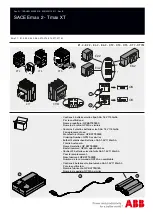
RECEIVING AND STORAGE
Each mechanism is carefully inspected and tested
at the factory and should be in good condition when
received. Inspection should be made to see that no
damage has occurred in shipment. Unpacking
should be done carefully, so as not to damage the
mechanism. All parts should be checked with the
shipping list and care should be taken not to leave
any part in the packing material. If the apparatus
as been damaged in any way, file a claim immedi-
ately with the carrier and notify the nearest West
inghouse Sales Office.
If the mechanism is to be stored, it should be kept
in a clean, dry place, protected from corrosion and
moisture. It should never be allowed to stand where
moisture can reach the wiring and insulated parts.
It would also be well to apply a coating of grease or
some rust inhibiting material on pins and bearings,
and especially on the latching surfaces of the latch
and trigger.
OPERATION
Before operating the mechanism for the first time,
remove all tags, instruction books, etc., from the
housing, read instructions given thereon, and file
for ready reference. Remove blocking from relays,
wire from main latch, and all other material which
was used for safe shipment. Before operating com
pressor, make sure that it is filled with a good grade
of SAE #30 Engine Oil (SAE #20 for extreme cold
weather conditions), that the belt and flywheel are
free from all foreign material, and that the valve at
the bottom of the storage tank is closed. In freezing
weather allow the space heaters to remain energized
several hours before operating compressor. Also
read the Westinghouse Air Brake Co. installation
and maintenance leaflet accompanying each com
pressor unit before operating.
Close the mechanism with the hand closing jack
once or twice before operating it with air just to
make sure that all moving parts of the mechanism
and breaker are free.
Caution:
Always make sure that the valve
between the storage tank and the in take
valve on the mechanism is closed before using
the hand closing jack or before doing any
work on the mechanism.
When the mechanism has been closed and
latched by the hand closing jack and it is desired to
open it in the same way, hold up on the trip armature
while backing off the jack so that the latch will be
released; otherwise the latch will hold the mechan
ism closed. Avoid letting the jack part way out be
fore releasing the latch as the blow may break the
bearing in the jack. Always make certain that the
jack is removed from the piston rod before operating
the mechanism by air or tripping it from the closed
position.
6
Simple Closing.
Starting with the mechanism
in the completely open position, when the control
switch on the switchboard (see diagram Fig. 3) is
turned to the "close" position, the
"X"
contactor on
the control panel closes. This energizes the magnet
coil of the magnetic pilot valve (see main section
view Fig.
1).
This coil opens the small magnetic
pilot valve, permitting air from the reservoir to flow
above the automatic intake valve piston. Since the
intake valve piston has an area larger than the face
of the valve, the intake valve is opened when pres
sure is applied. This permits air to flow through the
large air duct into the cylinder above the main
piston which is at the top of the cylinder in the fully
opened position.
If air were allowed to flow freely through the
large duct during the complete closing stroke, the
mechanism and breaker would be subjected to un
necessarily hard slamming. To prevent this, an
automatic throttle is provided to slow down the
normal closing operation. This throttling action is
accomplished as follows: The air is admitted at first
through a port which is partially closed by the
throttle valve piston. This opening is adjusted to
allow the minimum flow of air required to start the
breaker closed.
Just before the breaker picks up its contact load,
the throttle piston is automatically thrown to the wide
open position which admits the maximum amount of
air into the cylinder. This insures that sufficient pres
sure is available to close the breaker positively
against its contact load and possible short circuit
conditions, thus matching the inherent character
istics of the solenoid mechanism. The throttle adjust
ment has been set at the factory for best operation
and should not be disturbed.
I,
I
www
. ElectricalPartManuals
. com






























